Mobile CPU Wars: Core 2 Duo vs. Core Duo
by Anand Lal Shimpi on August 3, 2006 9:25 AM EST- Posted in
- CPUs
Application Performance using SYSMark 2004 SE
We'll kick off our look at general application performance with SYSMark 2004 SE as always, and we'll look at the overall score as well as the scores in each of the two suites - Internet Content Creation and Office productivity.
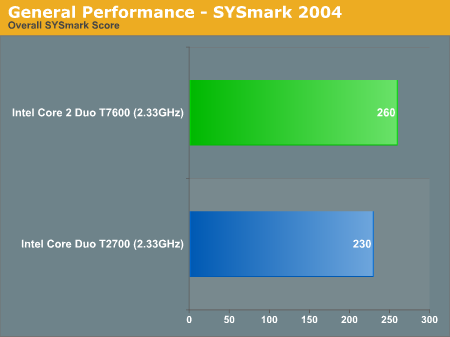
Clock-for-clock, Intel's Core 2 Duo is able to outperform its predecessor by 13% according to SYSMark 2004 SE's overall score. While the performance advantage isn't as dramatic as what we've seen on the desktop, comparing Core 2 to Pentium D, at 13% we're still looking at a performance gain that is noticeable in real world usage.
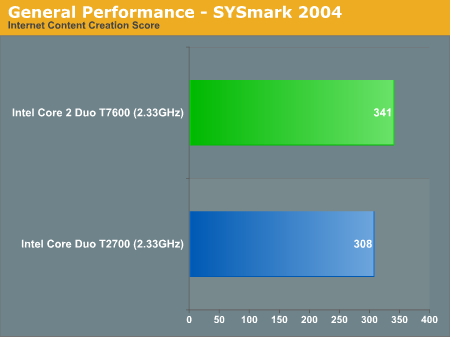
Drilling deeper and looking at the overall Internet Content Creation score, Core 2 Duo's performance advantage drops slightly to 10.7%. The performance increases we're seeing here highlight one very important point in current CPU architecture innovation. We're looking at a 10% increase in performance here, yet it required a 93% increase in transistor count to achieve (mostly because of the larger L2 cache, 4MB vs. 2MB). AMD and Intel are both looking to multi-core solutions to deliver better performance-per-transistor efficiency, rather than simply throwing more clock speed and cache at the problem.
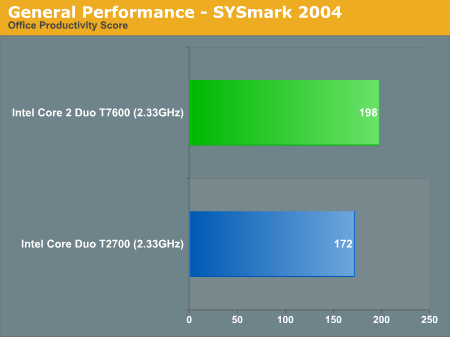
Speaking of the impacts of a larger L2 cache, we may be seeing those here in the Office Productivity suite where Core 2 Duo holds a 15.1% lead over Core Duo. The advantage is large enough to be noticeable, and definitely appreciated when you look at the fact that the Core 2 Duo we're benchmarking here has the same MSRP as its Core Duo predecessor.
The performance increases also come from the modified pipeline and internals, but we will have to get ahold of a 2MB Merom chip to determine exactly how much of the improvement comes from the added cache and how much comes from the reworked architecture.
The breakdown of SYSMark 2004 SE tests are below:


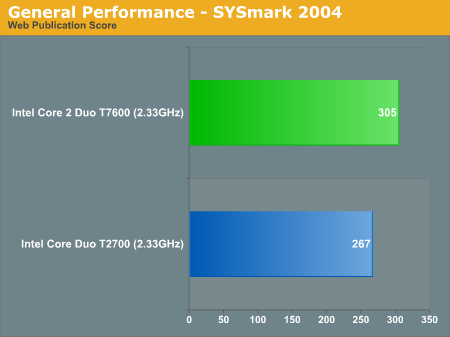

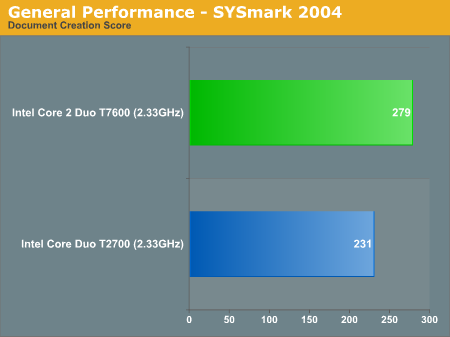











46 Comments
View All Comments
juanpoh - Friday, August 4, 2006 - link
Looking at http://www.intel.com/products/processor/pentiumm/i...">Intel Pentium M link, only 915 and 855 chipset is supported. However 945 chipset is listed as supported in http://www.intel.com/products/processor/celeron_m/...">Intel Celeron M link.jaybuffet - Friday, August 4, 2006 - link
I have the nx9420 notebook with the 945pm chipset... i was on hp support yesterday, and they said they would not support upgrading the CPU.. does that mean i am SOL because they wont upgrade the BIOS to support it?Pjotr - Friday, August 4, 2006 - link
Please correct the percentage numbers on http://www.anandtech.com/cpuchipsets/showdoc.aspx?...">http://www.anandtech.com/cpuchipsets/showdoc.aspx?..."17.5% increase in performance" -> "17.5 % less time used" OR "21.3 % increaase in performance"
Same mistake for all other time based benchmarks.
shecknoscopy - Thursday, August 3, 2006 - link
Given the nearly identical architectures of the desktop Conroes and the new Merom chips - how well do all of you think the two would stack up in a direct side-by-side comparison? This is open to blatant conjecture, of course, as the necessary hardware to <b>really</b> make a single-variable experiment isn't out there. But for those of us considering mobile-on-desktop options, how much of a performance cut would we see jumping from a Conroe to a Merom?IntelUser2000 - Saturday, August 5, 2006 - link
Intel mentioned something about having different prefetchers that match the market, meaning Woodcrest's Prefetchers are fit for workstation/server, Conroe for desktop, Merom for mobile applications(performance/battery life).
If you look at Core Extreme X6800 vs. Core 2 Duo E6700 benchmarks, you can see that in some reviews the differences are greater than the 267MHz clock difference(10% clock difference). Maybe Core Extreme has superior prefetchers to the Core 2 Duos, giving advantage in select few applications.
Sunrise089 - Thursday, August 3, 2006 - link
This was the exact question I just signed on to ask....so I await and answer as well.shecknoscopy - Thursday, August 3, 2006 - link
Woohoo! Great minds think alike, eh? Also, so do ours!JackPack - Thursday, August 3, 2006 - link
Which stepping did you use in this test? B1?EagleEye - Thursday, August 3, 2006 - link
I think the asus barebones configuration is mislabeled in this article. The s96j has the WXGA 1280x 800 screen while the z96j has the WSXGA 1680x 1050 screen. They either had an s96j or the native resolution is wrong as they stated it.Kalessian - Thursday, August 3, 2006 - link
I noticed that, too.